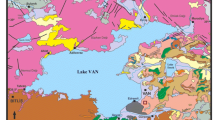Abstract
The standard penetration test (SPT) is the in situ test most commonly used to investigate the properties of silt, clay, sand and fine gravel. The Menard pressuremeter test (PMT) can be utilized to obtain the strength and deformation properties of any soil or weak rock. The study investigated the relationship between the corrected SPT blow count (N cor) and the PMT parameters of elastic modulus (E m) and limit pressure (p L). It is concluded that for the soils tested, E m and p L can be estimated as a function of N cor values, with r = 0.91 and 0.97, respectively.
Résumé
L’essai SPT (Standard Penetration Test) est l’essai in situ le plus couramment utilisé pour analyser les propriétés de silts, d’argiles, de sables et de graviers fins. L’essai pressiométrique Ménard peut être utilisé pour obtenir les caractéristiques de déformabilité et de résistance de tout type de sol ou de roche tendre. L’étude s’est intéressée aux relations entre d’une part, l’indice SPT corrigé N cor et d’autre part, les paramètres pressiométriques: le module pressiométrique E M et la pression limite p L. On conclut que, pour les sols testés, E M et p L peuvent être estimés en fonction de N cor, avec respectivement des coefficients de corrélation r = 0,91 et r = 0,97.




Similar content being viewed by others
References
ASTM (1995) Standard test method for pre-bored pressuremeter testing in soils (D4719). ASTM International, West Conshohocken, PA
ASTM (1999) Standard test method for penetration test and split-barrel sampling of soils (D1586). ASTM International, West Conshohocken, PA
Akca N (2003) Correlation of SPT–CPT data from the United Arab Emirates. Eng Geol 67:219–231
Baguelin F, Jezequel JF, Shields DH (1978) The pressuremeter and foundation engineering. Trans Tech Publications, Clausthal-Zellerfeld, Germany
Baguelin F, Bustamante M, Frank, RA (1986) The pressuremeter and foundations: French experience (ASCE Geotech Spec Publ 6: use of in situ tests in geotechnical engineering). ASCE, Reston, VA
Clayton CRI (1995) The standard penetration tests (SPT): methods and use (R143). CIRIA, London, p 144
Einstein HH, Baecher BG (1983) Probabilistic and statistical methods in engineering geology; specific methods and examples—Part 1: exploration (Rock mechanics and rock engineering, vol 16). Springer, Berlin, pp 39–72
Hasancebi N, Ulusay R (2007) Empirical correlations between shear wave velocity and penetration resistance for ground shaking assessments. Bull Eng Geol Environ 66:203–213
Hatanaka M, Uchida A (1996) Empirical correlation between penetration resistance and internal friction angle of sandy soils. Soil Found 36(4):1–10
Hughes JMO, Wroth GP, Windle D (1977) Pressuremeter tests in sand. Geotechnique 27(4)
Kulhawy FH, Mayne PW (1990) Manual on estimating soil properties for foundation design (final report, EL-6800). Electric Power Research Institute, Palo Alto, CA
Liao S, Whitman RV (1986) Overburden correction factor for SPT in sand. J Geotech Eng ASCE 112(3):373–377
Mair RJ, Wood DM (1987) Pressuremeter testing: methods and interpretation. CIRIA/Butterworths, London
Marcuson WF, Bieganousky WA (1977) SPT and relative density in coarse sands. J Geotech Eng Div ASCE 103(11):1295–1309
Menard L (1965) Rules for calculation of bearing capacity and foundation settlement based on pressuremeter tests. In: Proc 6th Int Conf on Soil Mechanics and Foundation Engineering, vol 2, Montreal, Canada, 8–15 Sept 1965, pp 295–299
Menard L (1975) The Menard pressuremeter: interpretation and application of the pressuremeter test results to foundations design. Sols–Soils 26
Nuyens J, Barnoud F, Gambin M (1996) The Menard pressuremeter test to foundation–an integrated concept. In: Craig (ed) Advances in site investigation practice. Thomas Telford, London, Sect 4b, pp 547–557
Ohya S, Imai T, Matsubara M (1982) Relationship between N value by SPT and LLT pressuremeter results. Proc 2nd Eur Symp on Penetration Testing, vol 1, Amsterdam, The Netherlands, 24–27 May 1982, pp 125–130
Rosenbaum MS, Rosén L, Gustafson G (1997) Probabilistic models for estimating lithology. Eng Geol 47(1/2):43–55
Schnaid F, Sills GC, Consoli NC (1996) Pressuremeter test in unsaturated soils. In: Craig (ed) Advances in site investigation practice. Thomas Telford, London, Sect 4b, pp 586–595
Seed HB, Arango I, Chan CK (1975) Evaluation of soil liquefaction potential during earthquake (report no. 75–28). Earthquake Research Center, University of California, Berkeley, CA
Skempton AW (1986) Standard penetration test procedures and the effect in sands of overburden pressure, relative density, particle size, aging and over-consolidation. Geotechnique 36(3):425–447
Sonmez H, Tuncay E, Gokceoglu C (2004) Models to predict the uniaxial compressive strength and the modulus of elasticity for Ankara agglomerates. Int J Rock Mech Min Sci 41(5):717–729
SPSS (2002) Statistical Package for the Social Sciences (v. 11.5). SPSS Inc., Chicago, IL
Thorburn S (1986) Field testing: the standard pentration test. In: Hawkins AB (ed) Site investigation practice: Assessing BS (British Standard) 5930. British Standards Institution, HMSO, London, pp 31–32
Yagiz S (2008) Utilizing rock mass properties for predicting TBM performance in hard rock condition. Tunneling Underground Space Technol 23/3:326–339
Acknowledgments
The authors would like to thank the Municipality of Gumusler County in the City of Denizli for financial support that made this research available.
Author information
Authors and Affiliations
Corresponding author
Rights and permissions
About this article
Cite this article
Yagiz, S., Akyol, E. & Sen, G. Relationship between the standard penetration test and the pressuremeter test on sandy silty clays: a case study from Denizli. Bull Eng Geol Environ 67, 405–410 (2008). https://doi.org/10.1007/s10064-008-0153-2
Received:
Accepted:
Published:
Issue Date:
DOI: https://doi.org/10.1007/s10064-008-0153-2




